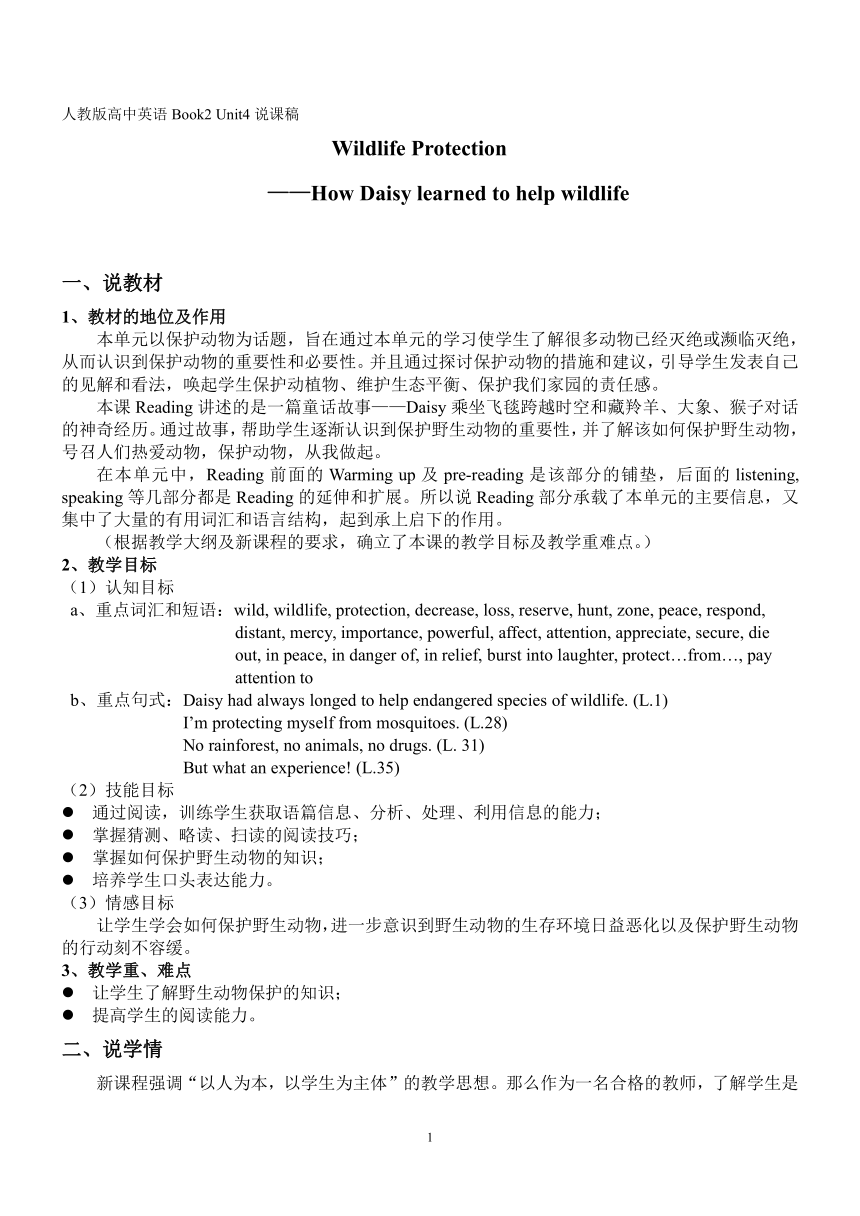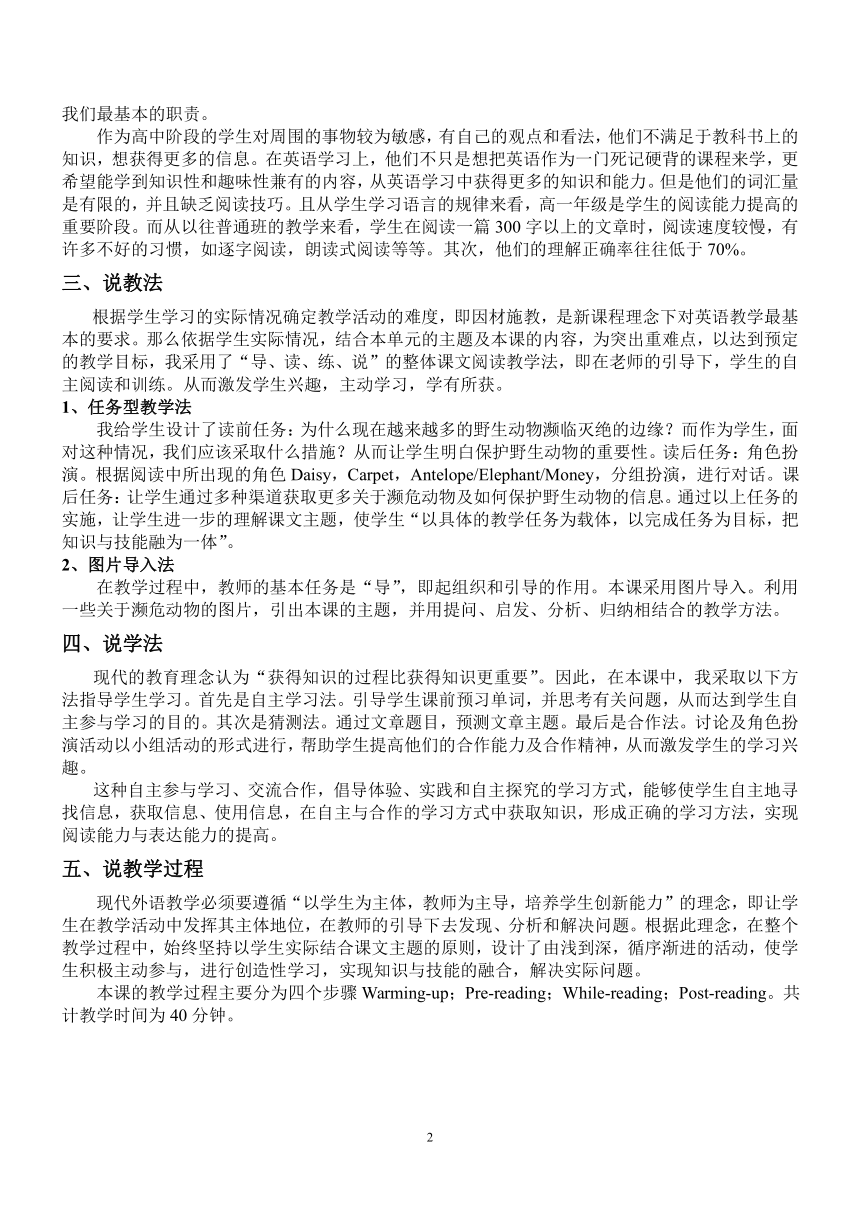人教版英语必修2 Unit4 Wildlife Protection说课稿
文档属性
| 名称 | 人教版英语必修2 Unit4 Wildlife Protection说课稿 |  | |
| 格式 | doc | ||
| 文件大小 | 70.0KB | ||
| 资源类型 | 教案 | ||
| 版本资源 | 人教版(新课程标准) | ||
| 科目 | 英语 | ||
| 更新时间 | 2021-07-23 11:42:42 | ||
图片预览


文档简介
人教版高中英语Book2 Unit4说课稿
Wildlife Protection
——How Daisy learned to help wildlife
一、说教材
1、教材的地位及作用
本单元以保护动物为话题,旨在通过本单元的学习使学生了解很多动物已经灭绝或濒临灭绝,从而认识到保护动物的重要性和必要性。并且通过探讨保护动物的措施和建议,引导学生发表自己的见解和看法,唤起学生保护动植物、维护生态平衡、保护我们家园的责任感。
本课Reading讲述的是一篇童话故事——Daisy乘坐飞毯跨越时空和藏羚羊、大象、猴子对话的神奇经历。通过故事,帮助学生逐渐认识到保护野生动物的重要性,并了解该如何保护野生动物,号召人们热爱动物,保护动物,从我做起。
在本单元中,Reading前面的Warming up及pre-reading是该部分的铺垫,后面的listening, speaking等几部分都是Reading的延伸和扩展。所以说Reading部分承载了本单元的主要信息,又集中了大量的有用词汇和语言结构,起到承上启下的作用。
(根据教学大纲及新课程的要求,确立了本课的教学目标及教学重难点。)
2、教学目标
(1)认知目标
a、重点词汇和短语:wild, wildlife, protection, decrease, loss, reserve, hunt, zone, peace, respond,
distant, mercy, importance, powerful, affect, attention, appreciate, secure, die
out, in peace, in danger of, in relief, burst into laughter, protect…from…, pay
attention to
b、重点句式:Daisy had always longed to help endangered species of wildlife. (L.1)
I’m protecting myself from mosquitoes. (L.28)
No rainforest, no animals, no drugs. (L. 31)
But what an experience! (L.35)
(2)技能目标
通过阅读,训练学生获取语篇信息、分析、处理、利用信息的能力;
掌握猜测、略读、扫读的阅读技巧;
掌握如何保护野生动物的知识;
培养学生口头表达能力。
(3)情感目标
让学生学会如何保护野生动物,进一步意识到野生动物的生存环境日益恶化以及保护野生动物的行动刻不容缓。
3、教学重、难点
让学生了解野生动物保护的知识;
提高学生的阅读能力。
二、说学情
新课程强调“以人为本,以学生为主体”的教学思想。那么作为一名合格的教师,了解学生是我们最基本的职责。
作为高中阶段的学生对周围的事物较为敏感,有自己的观点和看法,他们不满足于教科书上的知识,想获得更多的信息。在英语学习上,他们不只是想把英语作为一门死记硬背的课程来学,更希望能学到知识性和趣味性兼有的内容,从英语学习中获得更多的知识和能力。但是他们的词汇量是有限的,并且缺乏阅读技巧。且从学生学习语言的规律来看,高一年级是学生的阅读能力提高的重要阶段。而从以往普通班的教学来看,学生在阅读一篇300字以上的文章时,阅读速度较慢,有许多不好的习惯,如逐字阅读,朗读式阅读等等。其次,他们的理解正确率往往低于70%。
三、说教法
根据学生学习的实际情况确定教学活动的难度,即因材施教,是新课程理念下对英语教学最基本的要求。那么依据学生实际情况,结合本单元的主题及本课的内容,为突出重难点,以达到预定的教学目标,我采用了“导、读、练、说”的整体课文阅读教学法,即在老师的引导下,学生的自主阅读和训练。从而激发学生兴趣,主动学习,学有所获。
1、任务型教学法
我给学生设计了读前任务:为什么现在越来越多的野生动物濒临灭绝的边缘?而作为学生,面对这种情况,我们应该采取什么措施?从而让学生明白保护野生动物的重要性。读后任务:角色扮演。根据阅读中所出现的角色Daisy,Carpet,Antelope/Elephant/Money,分组扮演,进行对话。课后任务:让学生通过多种渠道获取更多关于濒危动物及如何保护野生动物的信息。通过以上任务的实施,让学生进一步的理解课文主题,使学生“以具体的教学任务为载体,以完成任务为目标,把知识与技能融为一体”。
2、图片导入法
在教学过程中,教师的基本任务是“导”,即起组织和引导的作用。本课采用图片导入。利用一些关于濒危动物的图片,引出本课的主题,并用提问、启发、分析、归纳相结合的教学方法。
四、说学法
现代的教育理念认为“获得知识的过程比获得知识更重要”。因此,在本课中,我采取以下方法指导学生学习。首先是自主学习法。引导学生课前预习单词,并思考有关问题,从而达到学生自主参与学习的目的。其次是猜测法。通过文章题目,预测文章主题。最后是合作法。讨论及角色扮演活动以小组活动的形式进行,帮助学生提高他们的合作能力及合作精神,从而激发学生的学习兴趣。
这种自主参与学习、交流合作,倡导体验、实践和自主探究的学习方式,能够使学生自主地寻找信息,获取信息、使用信息,在自主与合作的学习方式中获取知识,形成正确的学习方法,实现阅读能力与表达能力的提高。
五、说教学过程
现代外语教学必须要遵循“以学生为主体,教师为主导,培养学生创新能力”的理念,即让学生在教学活动中发挥其主体地位,在教师的引导下去发现、分析和解决问题。根据此理念,在整个教学过程中,始终坚持以学生实际结合课文主题的原则,设计了由浅到深,循序渐进的活动,使学生积极主动参与,进行创造性学习,实现知识与技能的融合,解决实际问题。
本课的教学过程主要分为四个步骤Warming-up;Pre-reading;While-reading;Post-reading。共计教学时间为40分钟。
步骤 教学过程 设计意图
Step I Warming up (6mins)
1. Show some pictures to students. (panda, Milu deer, South China tiger, rhino, antelope, elephant, gold monkey and so on.)
2. Ask students some questions:
1) Do you know what kind of animals they are?
(Protected species.)
2) Why people call them protected species?
(They are endangered; They are dying out.)
3) Why are they in danger of disappearing?
4) Discussion:
Nowadays, more and more animals are dying out. As a student, what should we do to protect wild animals?
T: You can join an organization which is interested in wildlife protection and they can be found all over the world. The WWF is just such an organization.
What is WWF?
---world’s largest privately financed conservation organization;
---protect endangered species and their habitats;
---works in more than 100 countries with nearly 5 million members. 利用图片进行导入,直观明了,能迅速抓住学生的注意力,引起学生的兴趣,尽快融入课堂。
让学生用已有的知识来分析野生动物濒临灭绝的原因,从而有效地引导学生进入本课主题——如何保护野生动物。不仅能够激发学习兴趣,还渗透德育教育,为下面的阅读作好铺垫。而讨论也有利于激发学生的分散性思维。
增加学生的课外知识,而不仅限于课本知识。
Step II Pre-reading (2mins) Prediction:
Look at the title to predict what the passage is about. 预测主题有助于学生把握文章的总体思想,培养学生的推理能力。
Step III While- reading
(22mins)
Task 1 Skimming for the general idea
What is this passage about?
Daisy took a flying carpet to travel and talked with some animals in her dream, which made her know the importance of the wildlife protection.
Task 2 Scanning for detailed information
1) Fill in the chart.
(What three places did Daisy go? What three animals did she meet? How Daisy felt?)
Places
Animals
Feelings
Tibet
Antelope
Sad
Zimbabwe
Elephant
Happy
Rainforest
Monkey
Amazed
2) True or false
1) Daisy saw many antelopes in Tibet. (F)
2) Daisy’s sweater was made of sheep wool. (F)
3) The elephant used to be well protected in Zimbabwe. (F)
4) In Zimbabwe, tourists love to see elephants. (T)
5) The farmers in Zimbabwe get nothing from the elephants now. (F)
Task 3 Careful reading
Answer the following questions:
Para.1: Why has the antelope in Tibet become an endangered species?
Para2: Why are elephant numbers increasing in Zimbabwe? How does the government of Zimbabwe help protect wild animals?
Para3: Why is it important to protect the rainforest?
Para.
Places
Animals
Situations
Feelings
1
Tibet
Antelope
They are killed for wool and their fur is used to make sweater.
Sad
2
Zimbabwe
Elephant
Farmers used to hunt them but now the government helps and the farmers who make money from tourism protect them.
Happy
3
Rainforest
Monkey
No rainforest, no animals and no drugs.
Amazed
中心大意的概括以填空的方式回答问题,降低难度,符合所教学生基础较差的实际情况。
安排一些知识性的问题,考查对阅读内容的进一步理解。培养学生对信息的理解和记忆,,提高判断能力。
问题的设计能够让学生了解各段的细节,明白野生动物们目前所处的情况及保护野生动植物的重要性。训练了学生的带着问题阅读文章及查读技巧。并培养学生利用信息口头表达能力。
Step IV Post-reading (9mins) Making up dialogues
1. Divide students into 3 groups.
Group 1: Students in threes make up a dialogue between Daisy, Carpet and Antelope.
Group 2: Students in threes make up a dialogue between Daisy, Carpet and Elephant.
Group 3: Students in threes make up a dialogue between Daisy, Carpet and Monkey.
2. Let students practice their dialogues in threes. 活动基于课文内容,又不局限于课文内容,目的在于发散学生的思维,把学习从课内拓展到课外。并为学生提供了训练口头表达能力的机会。实现了知识到技能的转化。
Step V Homework (1min) Collect as much information about endangered wildlife in rain forest / in the sea / on the high lands / in the river and how to protect wildlife as possible. 把英语学习从课堂引向了社会。
六、说板书设计
板书内容包括了While-reading中每一任务的问题答案。通过图表式的板书,让学生对文章内容一目了然,最终实现学生对信息的梳理,归纳和总结,使其的知识得到强化和巩固。
How Daisy learned to help wildlife
Main idea Daisy took a flying carpet to travel and talked with some animals in her dream, which made her know the importance of the wildlife protection.
Para. Places Animals Situations Feelings
1 Tibet Antelope They are killed for wool and their fur is used to make sweater.
Sad
2 Zimbabwe Elephant Farmers used to hunt them but now the government helps and the farmers who make money from tourism protect them. Happy
3 Rainforest Monkey No rainforest, no animals and no drugs. Amazed
4 Daisy returned home.
5
Wildlife Protection
——How Daisy learned to help wildlife
一、说教材
1、教材的地位及作用
本单元以保护动物为话题,旨在通过本单元的学习使学生了解很多动物已经灭绝或濒临灭绝,从而认识到保护动物的重要性和必要性。并且通过探讨保护动物的措施和建议,引导学生发表自己的见解和看法,唤起学生保护动植物、维护生态平衡、保护我们家园的责任感。
本课Reading讲述的是一篇童话故事——Daisy乘坐飞毯跨越时空和藏羚羊、大象、猴子对话的神奇经历。通过故事,帮助学生逐渐认识到保护野生动物的重要性,并了解该如何保护野生动物,号召人们热爱动物,保护动物,从我做起。
在本单元中,Reading前面的Warming up及pre-reading是该部分的铺垫,后面的listening, speaking等几部分都是Reading的延伸和扩展。所以说Reading部分承载了本单元的主要信息,又集中了大量的有用词汇和语言结构,起到承上启下的作用。
(根据教学大纲及新课程的要求,确立了本课的教学目标及教学重难点。)
2、教学目标
(1)认知目标
a、重点词汇和短语:wild, wildlife, protection, decrease, loss, reserve, hunt, zone, peace, respond,
distant, mercy, importance, powerful, affect, attention, appreciate, secure, die
out, in peace, in danger of, in relief, burst into laughter, protect…from…, pay
attention to
b、重点句式:Daisy had always longed to help endangered species of wildlife. (L.1)
I’m protecting myself from mosquitoes. (L.28)
No rainforest, no animals, no drugs. (L. 31)
But what an experience! (L.35)
(2)技能目标
通过阅读,训练学生获取语篇信息、分析、处理、利用信息的能力;
掌握猜测、略读、扫读的阅读技巧;
掌握如何保护野生动物的知识;
培养学生口头表达能力。
(3)情感目标
让学生学会如何保护野生动物,进一步意识到野生动物的生存环境日益恶化以及保护野生动物的行动刻不容缓。
3、教学重、难点
让学生了解野生动物保护的知识;
提高学生的阅读能力。
二、说学情
新课程强调“以人为本,以学生为主体”的教学思想。那么作为一名合格的教师,了解学生是我们最基本的职责。
作为高中阶段的学生对周围的事物较为敏感,有自己的观点和看法,他们不满足于教科书上的知识,想获得更多的信息。在英语学习上,他们不只是想把英语作为一门死记硬背的课程来学,更希望能学到知识性和趣味性兼有的内容,从英语学习中获得更多的知识和能力。但是他们的词汇量是有限的,并且缺乏阅读技巧。且从学生学习语言的规律来看,高一年级是学生的阅读能力提高的重要阶段。而从以往普通班的教学来看,学生在阅读一篇300字以上的文章时,阅读速度较慢,有许多不好的习惯,如逐字阅读,朗读式阅读等等。其次,他们的理解正确率往往低于70%。
三、说教法
根据学生学习的实际情况确定教学活动的难度,即因材施教,是新课程理念下对英语教学最基本的要求。那么依据学生实际情况,结合本单元的主题及本课的内容,为突出重难点,以达到预定的教学目标,我采用了“导、读、练、说”的整体课文阅读教学法,即在老师的引导下,学生的自主阅读和训练。从而激发学生兴趣,主动学习,学有所获。
1、任务型教学法
我给学生设计了读前任务:为什么现在越来越多的野生动物濒临灭绝的边缘?而作为学生,面对这种情况,我们应该采取什么措施?从而让学生明白保护野生动物的重要性。读后任务:角色扮演。根据阅读中所出现的角色Daisy,Carpet,Antelope/Elephant/Money,分组扮演,进行对话。课后任务:让学生通过多种渠道获取更多关于濒危动物及如何保护野生动物的信息。通过以上任务的实施,让学生进一步的理解课文主题,使学生“以具体的教学任务为载体,以完成任务为目标,把知识与技能融为一体”。
2、图片导入法
在教学过程中,教师的基本任务是“导”,即起组织和引导的作用。本课采用图片导入。利用一些关于濒危动物的图片,引出本课的主题,并用提问、启发、分析、归纳相结合的教学方法。
四、说学法
现代的教育理念认为“获得知识的过程比获得知识更重要”。因此,在本课中,我采取以下方法指导学生学习。首先是自主学习法。引导学生课前预习单词,并思考有关问题,从而达到学生自主参与学习的目的。其次是猜测法。通过文章题目,预测文章主题。最后是合作法。讨论及角色扮演活动以小组活动的形式进行,帮助学生提高他们的合作能力及合作精神,从而激发学生的学习兴趣。
这种自主参与学习、交流合作,倡导体验、实践和自主探究的学习方式,能够使学生自主地寻找信息,获取信息、使用信息,在自主与合作的学习方式中获取知识,形成正确的学习方法,实现阅读能力与表达能力的提高。
五、说教学过程
现代外语教学必须要遵循“以学生为主体,教师为主导,培养学生创新能力”的理念,即让学生在教学活动中发挥其主体地位,在教师的引导下去发现、分析和解决问题。根据此理念,在整个教学过程中,始终坚持以学生实际结合课文主题的原则,设计了由浅到深,循序渐进的活动,使学生积极主动参与,进行创造性学习,实现知识与技能的融合,解决实际问题。
本课的教学过程主要分为四个步骤Warming-up;Pre-reading;While-reading;Post-reading。共计教学时间为40分钟。
步骤 教学过程 设计意图
Step I Warming up (6mins)
1. Show some pictures to students. (panda, Milu deer, South China tiger, rhino, antelope, elephant, gold monkey and so on.)
2. Ask students some questions:
1) Do you know what kind of animals they are?
(Protected species.)
2) Why people call them protected species?
(They are endangered; They are dying out.)
3) Why are they in danger of disappearing?
4) Discussion:
Nowadays, more and more animals are dying out. As a student, what should we do to protect wild animals?
T: You can join an organization which is interested in wildlife protection and they can be found all over the world. The WWF is just such an organization.
What is WWF?
---world’s largest privately financed conservation organization;
---protect endangered species and their habitats;
---works in more than 100 countries with nearly 5 million members. 利用图片进行导入,直观明了,能迅速抓住学生的注意力,引起学生的兴趣,尽快融入课堂。
让学生用已有的知识来分析野生动物濒临灭绝的原因,从而有效地引导学生进入本课主题——如何保护野生动物。不仅能够激发学习兴趣,还渗透德育教育,为下面的阅读作好铺垫。而讨论也有利于激发学生的分散性思维。
增加学生的课外知识,而不仅限于课本知识。
Step II Pre-reading (2mins) Prediction:
Look at the title to predict what the passage is about. 预测主题有助于学生把握文章的总体思想,培养学生的推理能力。
Step III While- reading
(22mins)
Task 1 Skimming for the general idea
What is this passage about?
Daisy took a flying carpet to travel and talked with some animals in her dream, which made her know the importance of the wildlife protection.
Task 2 Scanning for detailed information
1) Fill in the chart.
(What three places did Daisy go? What three animals did she meet? How Daisy felt?)
Places
Animals
Feelings
Tibet
Antelope
Sad
Zimbabwe
Elephant
Happy
Rainforest
Monkey
Amazed
2) True or false
1) Daisy saw many antelopes in Tibet. (F)
2) Daisy’s sweater was made of sheep wool. (F)
3) The elephant used to be well protected in Zimbabwe. (F)
4) In Zimbabwe, tourists love to see elephants. (T)
5) The farmers in Zimbabwe get nothing from the elephants now. (F)
Task 3 Careful reading
Answer the following questions:
Para.1: Why has the antelope in Tibet become an endangered species?
Para2: Why are elephant numbers increasing in Zimbabwe? How does the government of Zimbabwe help protect wild animals?
Para3: Why is it important to protect the rainforest?
Para.
Places
Animals
Situations
Feelings
1
Tibet
Antelope
They are killed for wool and their fur is used to make sweater.
Sad
2
Zimbabwe
Elephant
Farmers used to hunt them but now the government helps and the farmers who make money from tourism protect them.
Happy
3
Rainforest
Monkey
No rainforest, no animals and no drugs.
Amazed
中心大意的概括以填空的方式回答问题,降低难度,符合所教学生基础较差的实际情况。
安排一些知识性的问题,考查对阅读内容的进一步理解。培养学生对信息的理解和记忆,,提高判断能力。
问题的设计能够让学生了解各段的细节,明白野生动物们目前所处的情况及保护野生动植物的重要性。训练了学生的带着问题阅读文章及查读技巧。并培养学生利用信息口头表达能力。
Step IV Post-reading (9mins) Making up dialogues
1. Divide students into 3 groups.
Group 1: Students in threes make up a dialogue between Daisy, Carpet and Antelope.
Group 2: Students in threes make up a dialogue between Daisy, Carpet and Elephant.
Group 3: Students in threes make up a dialogue between Daisy, Carpet and Monkey.
2. Let students practice their dialogues in threes. 活动基于课文内容,又不局限于课文内容,目的在于发散学生的思维,把学习从课内拓展到课外。并为学生提供了训练口头表达能力的机会。实现了知识到技能的转化。
Step V Homework (1min) Collect as much information about endangered wildlife in rain forest / in the sea / on the high lands / in the river and how to protect wildlife as possible. 把英语学习从课堂引向了社会。
六、说板书设计
板书内容包括了While-reading中每一任务的问题答案。通过图表式的板书,让学生对文章内容一目了然,最终实现学生对信息的梳理,归纳和总结,使其的知识得到强化和巩固。
How Daisy learned to help wildlife
Main idea Daisy took a flying carpet to travel and talked with some animals in her dream, which made her know the importance of the wildlife protection.
Para. Places Animals Situations Feelings
1 Tibet Antelope They are killed for wool and their fur is used to make sweater.
Sad
2 Zimbabwe Elephant Farmers used to hunt them but now the government helps and the farmers who make money from tourism protect them. Happy
3 Rainforest Monkey No rainforest, no animals and no drugs. Amazed
4 Daisy returned home.
5
